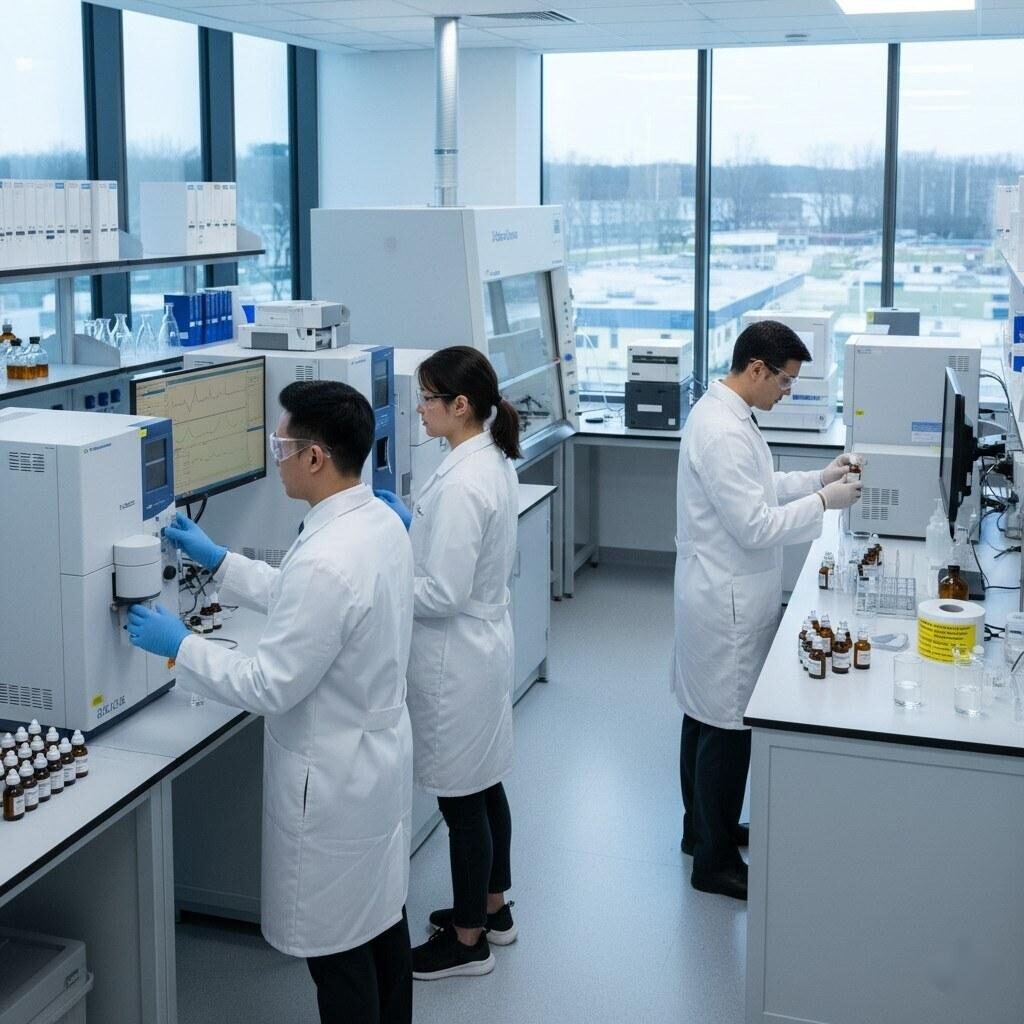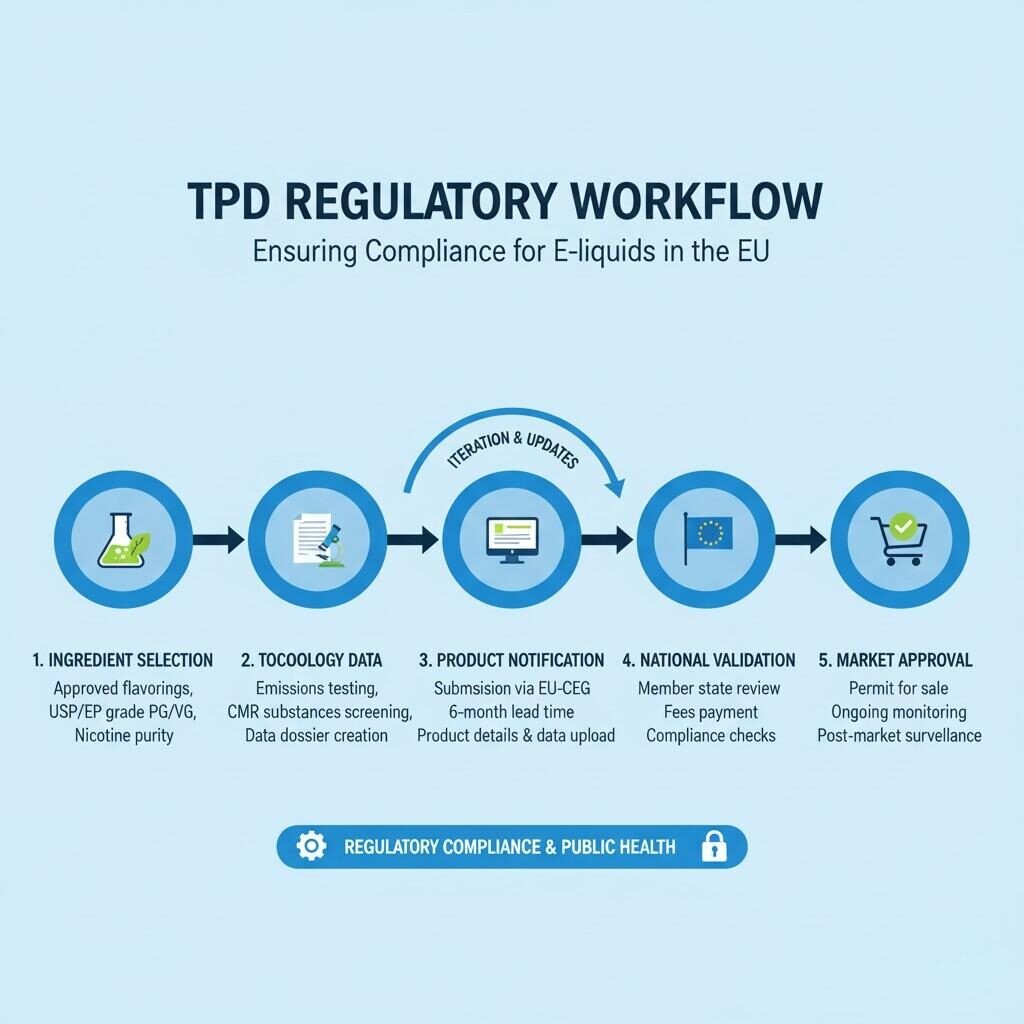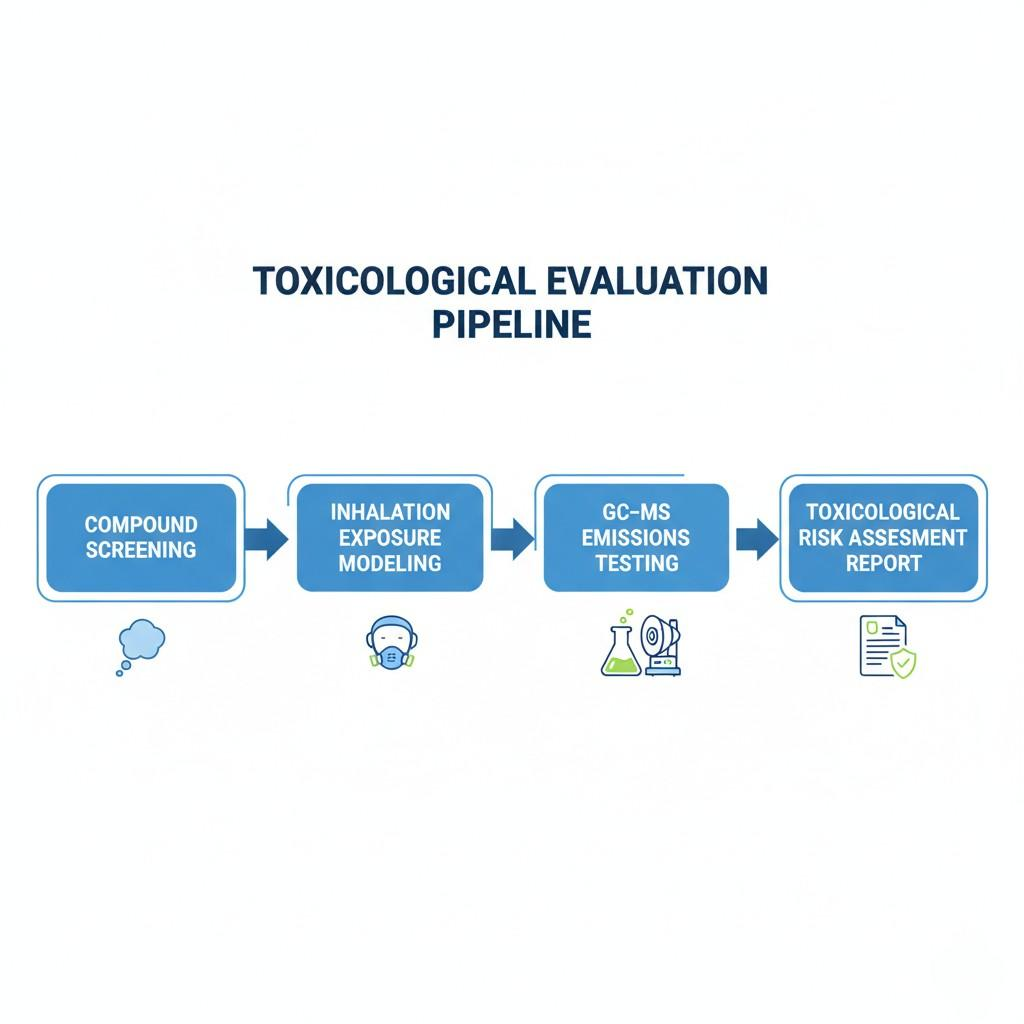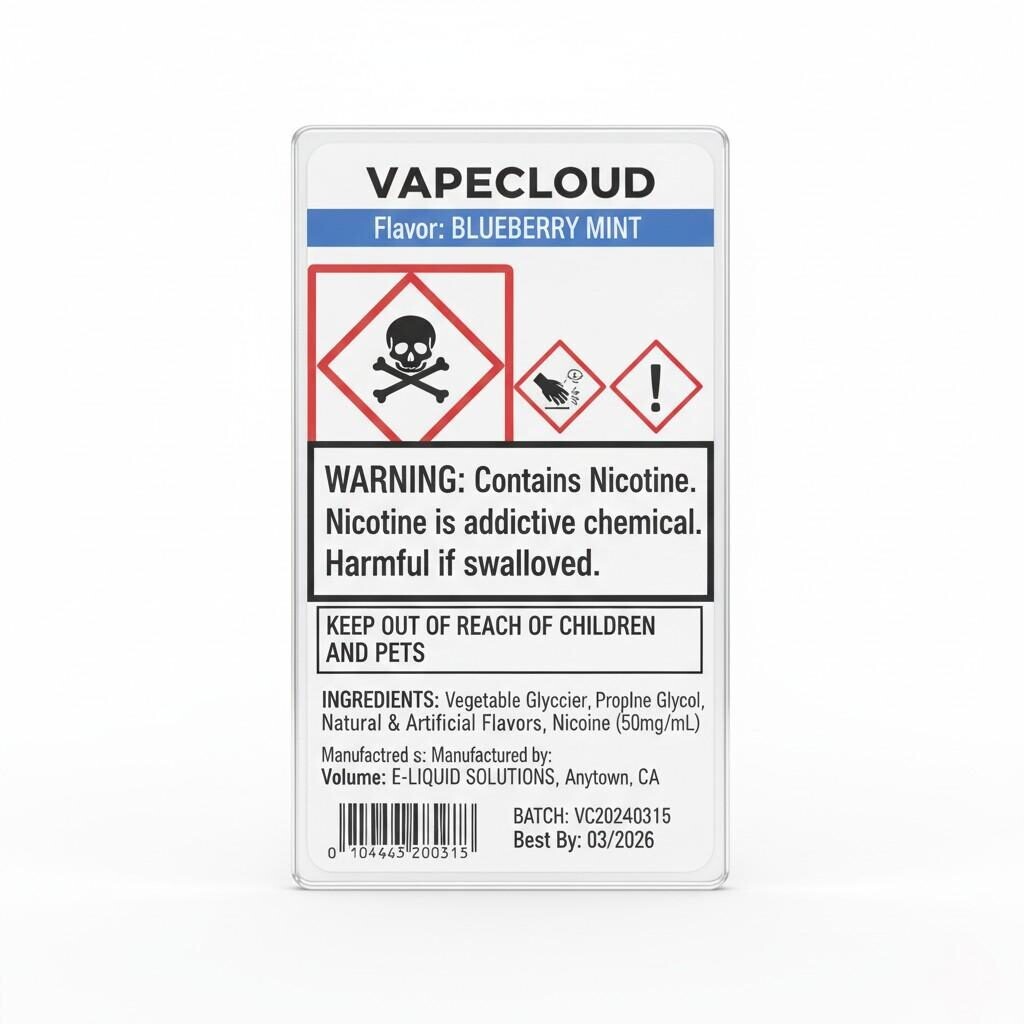Author:R&D Team, CUIGUAI Flavoring
Published by:Guangdong Unique Flavor Co., Ltd.

E-liquid Lab & Compliance
In the rapidly evolving e-liquid industry,safety, transparency, and compliancehave become as crucial as creativity and sensory appeal.
Since the introduction of theDiretiva de Produtos de Tabaco (TPD)by the European Union, manufacturers of e-liquids and vape flavorings are required to meetstrict regulatory standardsgoverning product formulation, labeling, and market authorization.
For professional flavor manufacturers and vape brands, understandingTPD complianceis no longer optional — it is atechnical and legal necessitythat directly affects market access, consumer trust, and long-term brand sustainability.
This guide explores, in depth, how toformulate e-liquid flavoringsthat fully comply with TPD regulations — from ingredient selection and toxicological screening to submission protocols and labeling requirements.
We will also discuss practical formulation tips and scientific best practices that ensureflavor quality, safety, eregulatory conformity.
OTobacco Products Directive (2014/40/EU), implemented in May 2016, established a unified regulatory framework across all EU member states for the manufacturing, presentation, and sale of tobacco and related products — includinge-cigarettes and refill liquids.
According toArticle 20of the Directive, e-liquids containing nicotine must comply with specificcomposition, notification, and packaging requirements[¹].
Even though flavorings are not always classified as “tobacco” components,any ingredientused in a product intended for inhalation must meet the samepurity and toxicological standards.
For e-liquid flavor developers, this means each aroma compound — from fruit esters to sweeteners and cooling agents — must beevaluated, documented, and disclosedin a detailed regulatory dossier.

TPD Regulatory Workflow
The TPD’s requirements extend not only to e-liquid brands but also toflavor suppliers, as they provide the raw materials used in final nicotine-containing products.
All substances used in e-liquid flavorings must:
Flavor compounds should also be evaluated forthermal decompositionrisks to ensure that no harmful byproducts (formaldehyde, acetaldehyde, etc.) form during heating.
Manufacturers must provide:
These documents are critical forTPD notification submissionsand must be reviewed by qualified toxicologists.
Every e-liquid product containing nicotine must be notified to theEU Common Entry Gate (EU-CEG)portal at least6 months before marketing.
This process requires detailed disclosure of:
Even non-nicotine e-liquids are now subject to similar national-level requirements in many EU countries (e.g., France, Germany, and Italy).
The TPD bans or restricts any additive that:
Commonly prohibited or restricted compounds include:
| Compound | Reason for Restriction | TPD Compliance Status |
| Diacetyl (2,3-butanedione) | Respiratory risk (bronchiolitis obliterans) | Prohibited |
| Acetoin | Potential precursor to diacetyl formation | Restrito |
| Acetyl propionyl | Similar toxicity to diacetyl | Prohibited |
| Cinnamaldehyde | Cytotoxicity under vaporization | Restrito |
| Coumarin | Toxicological concerns (liver toxicity) | Prohibited |
| Essential oils (unrefined) | May contain allergens or reactive terpenes | Restrito |
According to theEuropean Chemicals Agency (ECHA), all substances must be screened under theCLP Regulation (EC No. 1272/2008)for hazard classification before inclusion in e-liquid flavor formulations [²].
Formulating compliant e-liquid flavorings is not just about removing restricted compounds — it involvestechnical balancebetween sensory design and chemical stability.
Common flavor carriers likePropileno glicol (PG)etriacetinmust meet:
Solvent ratio affectsflavor volatility, diffusion rate, ecoil performance— crucial parameters in consumer safety and product consistency.
Natural extracts can enhance authenticity but often containtrace allergens or unstable terpenes.
Synthetic analogs offerpurity, consistency, and control, making them preferred for regulatory compliance.
A hybrid approach — combiningnatural-identical moleculeswith controlled synthetics — often achieves bothTPD safetyeflavor fidelity.
Every compound must be tested forthermal stabilityunder vaporization conditions (typically 180–250°C).
Compounds that decompose into aldehydes, ketones, or acids under heat should be replaced or reformulated.
AdvancedGC–MS and TGA analysiscan identify potential breakdown pathways, ensuring a flavor remains inert and safe during vaping.

Toxicological Evaluation Flowchart
The TPD explicitly requires manufacturers to provide information ontoxicological data of each ingredient, particularly in the context ofinhalation exposure.
This distinguishes e-liquid flavor formulation from food or cosmetic flavoring.
A professional evaluation includes:
Industry guidelines from theFlavor and Extract Manufacturers Association (FEMA)eEuropean Food Safety Authority (EFSA)provide reference exposure limits for common aroma compounds [³].
E-liquid flavor formulators must ensure ingredient usage levels remainwell below inhalation-based toxicity thresholds, even under concentrated conditions.
A completeTPD submission dossierincludes the following technical files:
These documents are uploaded via theEU Common Entry Gate (EU-CEG)platform, where each product receives a uniquesubmission IDrecognized by all EU Member States.
Submission fees and procedures vary slightly by country but follow harmonized EU guidelines, as outlined by theEuropean Commission’s Health and Food Safety Directorate (DG SANTE)[⁴].
TPD compliance extends beyond paperwork — it requiressystematic controlat every production stage.
E-liquid flavor facilities should operate under:
Batch samples should be retained for2 years minimum, ensuring traceability for audits or incident investigations.
Even trace allergens likelimonene, linalool, or citralmust be declared and limited.
All raw materials must be screened for:
RoutineGC–MS purity testingensures flavor formulations remain compliant and safe for long-term inhalation.
Each production lot should have:
Digital compliance management software can automate reporting forEU-CEGsubmissions andISO 9001documentation.

E-Liquid Label Example
TPD-compliant e-liquid labels must include the following elements:
All ingredients, including flavorings, must be listed by descending weight and include relevantNúmeros CASif requested.
All e-liquid containers must be:
Under Article 20,no claims suggesting health, vitality, or reduced harmmay be made.
Flavor names and imagery should avoid references tofoods, beverages, or candies appealing to minors.
| Mistake | Consequence | Preventive Action |
| Using food-grade but not inhalation-tested flavors | Regulatory rejection or health risk | Use only TPD-screened ingredients |
| Missing toxicology documentation | EU-CEG submission failure | Partner with accredited toxicology consultants |
| Non-conforming labeling (font size, warnings) | Product recall or fines | Follow Article 20 label templates |
| Inconsistent batch records | Loss of compliance traceability | Implement digital GMP tracking |
| Ignoring national variations (e.g., France ANSES) | Market entry delays | Review local implementation guides |
Compliance is not a one-time task but an ongoing process ofmonitoring, documentation, and re-evaluationas regulatory science evolves.
As vaping technology advances, future revisions to the TPD are expected totighten ingredient controls, expand non-nicotine coverage, eincrease toxicological transparency.
Industry experts anticipate:
Manufacturers that proactively align withscientific risk assessment methods, transparent labeling, andsustainable ingredient sourcingwill be best positioned for long-term success in both EU and global markets.
TPD compliance is not a bureaucratic burden — it’s a framework forsafety, quality, and consumer confidence.
By integrating compliance from the earliest stages of flavor formulation, manufacturers can differentiate themselves throughtrust and technical excellence.
NoAromatizante CUIGUAI, we specialize inTPD-compliant e-liquid flavor systems— rigorously tested for purity, stability, and sensory performance.
Our flavors are backed byGC–MS analysis, toxicological documentation, eISO-certified quality systems, ensuring full regulatory compatibility across European and global markets.
Ready to developTPD-compliant e-liquid flavorsfor your next product line?
Contact our technical experts forformulation support, compliance consulting, or free flavor samplestailored to your regulatory needs.
👉Request Technical Consultation or Free Sample
📩[info@cuiguai.com]
📞[+86 189 2926 7983]
🌐 Explore more at【www.cuiguai.com】
[¹] European Parliament and Council.Directive 2014/40/EU on the manufacture, presentation and sale of tobacco and related products.(EUR-Lex, 2016).
[²] European Chemicals Agency (ECHA).CLP Regulation (EC No. 1272/2008).https://echa.europa.eu/clp-regulation
[³] European Food Safety Authority (EFSA).Scientific Opinion on the evaluation of flavoring substances.EFSA Journal, 2022.
[⁴] European Commission DG SANTE.EU Common Entry Gate (EU-CEG) User Guide.2023.
O escopo de negócios inclui projetos licenciados: produção de aditivos alimentares. Projetos gerais: vendas de aditivos alimentares; fabricação de produtos químicos diários; vendas de produtos químicos diários; serviços técnicos, desenvolvimento de tecnologia, consultoria técnica, intercâmbio de tecnologia, transferência de tecnologia e promoção de tecnologia; pesquisa e desenvolvimento de rações biológicas; pesquisa e desenvolvimento de preparação enzimática industrial; atacado de cosméticos; agência de comércio doméstico; vendas de produtos sanitários e suprimentos médicos descartáveis; varejo de utensílios de cozinha, louças sanitárias e artigos diversos; vendas de necessidades diárias; vendas de alimentos (apenas vendas de alimentos pré-embalados).
Direitos autorais ©Guangdong Unique Flavor Co., Ltd.Todos os direitos reservados. Política de privacidade